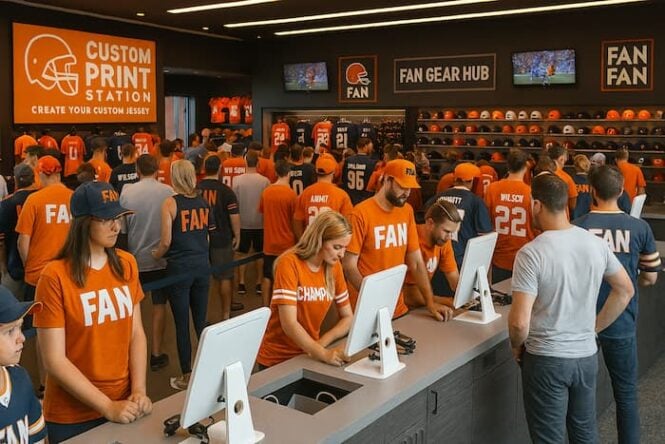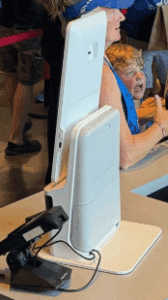
Stadium Shopping in Minutes
The article discusses the rapid expansion of RFID tags self-checkout technology in merchandise stores within U.S. professional sports venues. This technology enables fans to quickly purchase items using RFID-tagged products, streamlining the shopping experience and reducing wait times at checkout. As a result, stadiums and arenas are seeing higher sales efficiency and improved customer satisfaction, with many venues adopting these systems to modernize retail operations and keep pace with growing demand for faster service.Read full article at Stadium Report
Summary
RFID self-checkout technology has rapidly transformed the retail experience within U.S. pro sports venues, offering significant benefits to fans, stadium operators, and retail staff. Here’s a detailed look at the facts, technical points, and broad impacts of this innovation across the industry.
What RFID Tags Self-Checkout Is
RFID (Radio Frequency Identification) self-checkout is a retail technology where merchandise is tagged with RFID chips. In stadium stores equipped with systems like EXO Checkout, fans simply drop their selected merchandise into a sink-like bin lined with RFID sensors. The system instantly recognizes each item, lists their prices, and presents a payment prompt—enabling customers to buy multiple items in 30 seconds or less. For comparison, traditional barcode or staffed checkouts can take several minutes per transaction, especially during peak event times.
Benefits for Fans and Shoppers
-
Wait times are nearly eliminated, allowing fans to shop for gear quickly and return to their seats without missing the action.
-
Transactions have been measured to be up to four times faster than old point-of-sale (POS) systems and three times faster than barcode-based checkouts.
-
Some systems allow self-checkout from mobile, hand-held, or permanent stations, and are even available as portable units for pop-up events or peak periods.
Operational and Staffing Gains
-
Vast reduction in staff time tied to registers or POS stations. Just a handful of employees can now supervise multiple RFID checkout bins, while others are freed up for customer service on the floor (such as helping fans with product selections or sizes).
-
Inventory management is vastly improved. Items in-store are RFID-tagged, enabling near-instant inventory counts with handheld RFID “guns.” This can be done in minutes—previously, such counts took hours and were less accurate.
-
Inventory accuracy rises to nearly 100 percent, eliminating frequent stock errors. Weekly inventories are now realistic, compared to past annual or quarterly cycles.
Retailer and Venue ROI
-
Venues adopting RFID self-checkout report paying off their investment in technology quickly—sometimes by the second event after deployment—due to increased throughput and sales.
-
Stores also see reduced theft (thanks to integrated loss prevention) and a drop in lost inventory due to missed sales or stock-outs.
-
Labor savings are substantial: pilot stadiums report labor needs reduced by up to 40 percent for running retail operations, providing further incentive for adoption.
Technology Adoption and Penetration
-
RFID self-checkout vendors, most notably EXO Checkout, have quickly expanded into dozens of large pro sports venues, including NFL and MLB stadiums and high-profile events such as the Super Bowl.
-
Major brands like Nike and New Era are already tagging much of their apparel with RFID, accelerating the shift to this fast, automated checkout model.
-
Leading stadiums such as Yankee Stadium now feature dozens of RFID checkout stations, achieving higher speed and customer satisfaction.
-
Amazon’s “Just Walk Out” RFID system, which includes RFID checkout lanes and gates, has also gained traction in venues but trails EXO in deployment scale within sports retail. Amazon’s system enables frictionless shopping but is often paired with other tech like cameras for truly staffless stores.
Industry Collaboration and Future Trends
-
Retail tech partners such as Teamwork Commerce are integrating robust POS capabilities with RFID checkout technology, leading to even smoother retail operations at busy venues.
-
As more suppliers provide merchandise pre-tagged with RFID, the need for manual tagging will decline, further reducing staff workload and human error.
-
Other retail chains and arena types—including international venues—are looking to RFID self-checkout for improved speed, sustainability (reduced waste), and climate-neutral retailing.
RFID Tags Self-Checkout The Broader Impact
-
Improved back-end logistics, with RFID enabling full traceability from warehouse to sales floor and even into after-sales and returns. This boosts efficiency, sustainability, and customer service.
-
RFID systems allow venues to expand sales floors, reduce storage needs, and keep in-demand items in stock, addressing lost revenue from empty shelves.
-
Fans at major sports and entertainment venues are increasingly likely to expect and demand quick, seamless shopping—now a realistic standard thanks to RFID self-checkout.
- And then there are inventory considerations…
RFID self-checkout is not just a trend but a fundamental shift in how stadium merchandise stores operate—delivering speed, efficiency, and new capabilities that benefit every stakeholder involved
RFID Tags Self-Checkout Articles
- RFID Readers for EV Chargers: Six Questions to Ask
- RFID Kiosk RFID Scanner – The Risks
- Security Stadium Biometrics – Fan Experience, Safer, Data Insights
- Top Ten Questions About Kiosks Always Asked
More RFID Resources
- RFID in self-checkout
- RFID history
- IOTForAll article
- Teamwork Self-Checkout — Self-checkout has become a staple of today’s in-store retail environment. In fact, a 2024 study conducted by PYMNTS found that two-thirds (66%) of US consumers prefer self-checkout to staffed checkouts, with Generation Z (84%) and millennials (76%) leading the way in embracing the technology.



